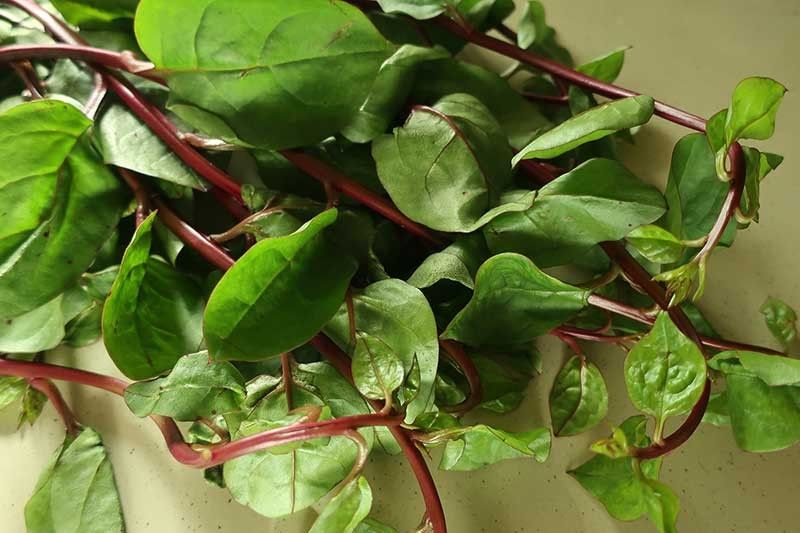From salad to omelette: Filipino chefs list ways to enjoy Alugbati

MANILA, Philippines — Alugbati is a green leafy vegetable that goes by the names Malabar spinach, Indian spinach, Chinese spinach, climbing spinach, cyclone spinach, and vine spinach in English.
Despite its English names, however, it is not a type of spinach. Its leaves just resemble spinach leaves and the taste profile is kind of similar, too, but Alugbati is actually a type of climbing vine with very sturdy leaves that are dark green in color. Some varieties, such as the ones usually found in wet markets and supermarkets, have dark reddish purple outlines on their leaves and stems.
Alugbati is very nutritious. Aside from dietary fiber, it contains vitamins and minerals such as calcium, iron, potassium, magnesium, copper, manganese, Vitamin A, B1 (thiamin), 2 (riboflavin), B3 (niacin), B6, B9 (folic acid), and C, as well as small amounts of phosphorus, selenium, Vitamin B5, and zinc. This green leafy vegetable also contains plenty of antioxidants, including flavonoids and phenolic acids, as well as beneficial bioactive compounds.
Nutritious as it is, alugbati also presents a lot of health benefits, as it helps reduce and prevent gastrointestinal ulcers, promote healing of wounds, protect the kidneys and liver, prevent diabetes, reduce inflammation, and help treat skin diseases, among others.
Given these many benefits, many still hesitate to eat Alugbati since they do not quite know how to prepare and cook it.
Here are some suggestions from some of the top Filipino chefs who advocate buying and eating local:
Chef Gino Gonzalez
Chef Gino from the Center for Asian Culinary Studies (CACS) enjoys his Alugbati by sauteing it with bagoong and some pork or just top it with Chicharon after cooking.
Chef Waya Araos-Wijangco
Gypsy Baguio's Chef Waya recalled growing up with her lola and mom putting Alugbati leaves in monggo and eating it as a salad.
For salad, the Alugbati is plainly blanched and eaten with bagoong, calamansi and tomatoes. Lately, Chef Waya has been enjoying it as ohitashi, the simple Japanese salad usually made with spinach but is also excellent with Alugbati.
Chef Christopher Guado Carangian
Chef Christopher from Zicreto and the Culinary Generals of the Philippines adds the Alugbati to Ginisang Sardinas.
It is also added to other ginisang gulay (sauteed vegetable) recipes.
"That’s usually how Alugbati is prepared in our household when I was growing up. I’ve also seen this practice mostly in Central Luzon and in the Visayas. Alugbati is also good as a salad," said Chef Christopher.
Chef Jam Melchor
Culinary Historians of the Philippines' Chef Jam recommended to include Alugbati in omelette.
"For a heary breakfast, I mix Alugbati leaves with eggs, tomatoes, and a bit of cheese to make an omelette," said the chef.
The leaves add texture and serve as nutritional boost. When fresh, young leaves are available, Alugbati also makes a vibrant and nutritious salad. The chef tosses it with tomatoes and onion and adds vinaigrette dressing for a refreshing salad.
Chef Myke ‘Tatung’ Sarthou
YouTube content creator, author and the chef behind Azadore, Lore and Tindeli, Chef Myke "Tatung" Sarthou prefers to saute Alugbati or adds it to monggo or other soups.




















